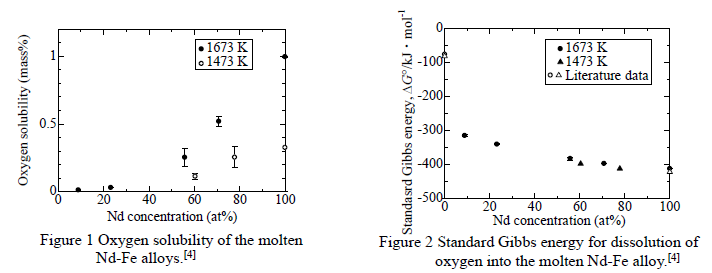
Thermodynamics of Oxygen in Rare Earth Magnet
Prof. Yoshinao Kobayashi
Date & Time: 15:30 - 16:30, September 27th (Tue), 2022.
Place: 5F conference room (#513-514), Advanced Structural Materials Bldg., Sengen.
Abstract:
Rare earth magnets, such as Nd-Fe-B magnet and Sm-Fe-N magnet, are of great importance for its excellent magnetic property. Especially, sintered Nd-Fe-B magnet has the highest magnetic property among the magnets currently used. However, since its coercivity largely decreases under high temperature environments, coercivity enhancement is indispensable. For this purpose, Cu and Dy are commonly added to Nd-Fe-B magnet, which improves microstructure of Nd-Fe-B magnet [1,2]. However, oxygen content in Nd-Fe-B magnet is known to oxidize the magnet’s microstructure and deteriorate its coercivity. Therefore, it is vital to suppress oxidation of Nd-Fe-B magnet alloy in manufacturing process. From this point of view, it is quite important to comprehend thermodynamic property of oxygen in Nd-Fe-B magnet alloy. Similarly, Sm-Fe-N magnet is a promising magnet material, but its coercivity is also decreased by oxygen content [3].
Therefore, our research intended to clarify thermodynamic property of oxygen in Nd-Dy-Fe-Cu-B alloy and Sm-Fe-N alloy by measuring the oxygen solubility of these molten alloy. Figure 1 shows the oxygen solubility of molten Nd-Fe alloy. The figure shows that oxygen solubility largely decreases along with decrement of temperature and Nd composition, ranging from 0.01mass% for Fe-8.9 at%Nd to 1 mass% for pure Nd. To evaluate the affinity between oxygen and Nd-Fe molten alloy, we calculated the standard Gibbs energies for the oxygen dissolution into the molten Nd-Fe alloy and Figure 2 shows the results. Figure 2 shows that the values of ΔG゜for pure Fe and Nd are quite different and ΔG゜for Nd-Fe alloy slightly increases along with increment of Fe composition. This fact means that the affinity between oxygen and Nd-Fe molten alloy is almost dominated by Nd. In the lecture, the effect of Dy, Cu, B addition and comparison between Nd-Fe and Sm-Fe systems will also be described.
Therefore, our research intended to clarify thermodynamic property of oxygen in Nd-Dy-Fe-Cu-B alloy and Sm-Fe-N alloy by measuring the oxygen solubility of these molten alloy. Figure 1 shows the oxygen solubility of molten Nd-Fe alloy. The figure shows that oxygen solubility largely decreases along with decrement of temperature and Nd composition, ranging from 0.01mass% for Fe-8.9 at%Nd to 1 mass% for pure Nd. To evaluate the affinity between oxygen and Nd-Fe molten alloy, we calculated the standard Gibbs energies for the oxygen dissolution into the molten Nd-Fe alloy and Figure 2 shows the results. Figure 2 shows that the values of ΔG゜for pure Fe and Nd are quite different and ΔG゜for Nd-Fe alloy slightly increases along with increment of Fe composition. This fact means that the affinity between oxygen and Nd-Fe molten alloy is almost dominated by Nd. In the lecture, the effect of Dy, Cu, B addition and comparison between Nd-Fe and Sm-Fe systems will also be described.

【References】
[1] M. Sagawa, S. Hirosawa, K. Tokuhara, H. Yamamoto, S. Fujimura, Y. Tsoumada and R. Shimizu: J. Appl. Phys.
61 (1987) 35593561.
[2] S. Nishio, R. Goto, M. Matsuura, N. Tezuka, S. Sugimoto:J. Jpn. Inst. Metals. 72 (2008) 1010–1014.
[3] K. Takagi, H. Nakayama and K. Ozaki: J. Magn. Magn. Mater. 324 (2012) 2336-2341.
[4] T. Oshino, Y. Kobayashi, T. Abe and T. Koyama: Mater. Trans. 57 (2016) 17711775.
[1] M. Sagawa, S. Hirosawa, K. Tokuhara, H. Yamamoto, S. Fujimura, Y. Tsoumada and R. Shimizu: J. Appl. Phys.
61 (1987) 35593561.
[2] S. Nishio, R. Goto, M. Matsuura, N. Tezuka, S. Sugimoto:J. Jpn. Inst. Metals. 72 (2008) 1010–1014.
[3] K. Takagi, H. Nakayama and K. Ozaki: J. Magn. Magn. Mater. 324 (2012) 2336-2341.
[4] T. Oshino, Y. Kobayashi, T. Abe and T. Koyama: Mater. Trans. 57 (2016) 17711775.